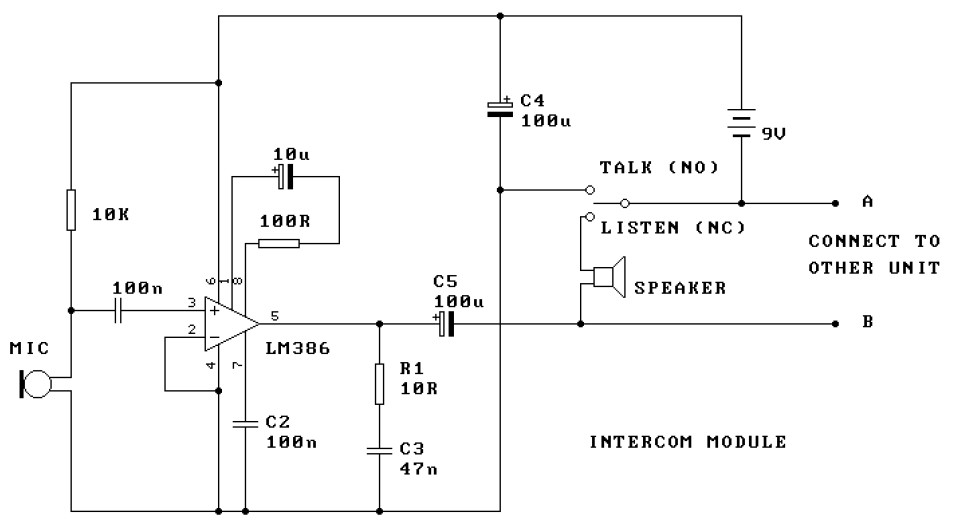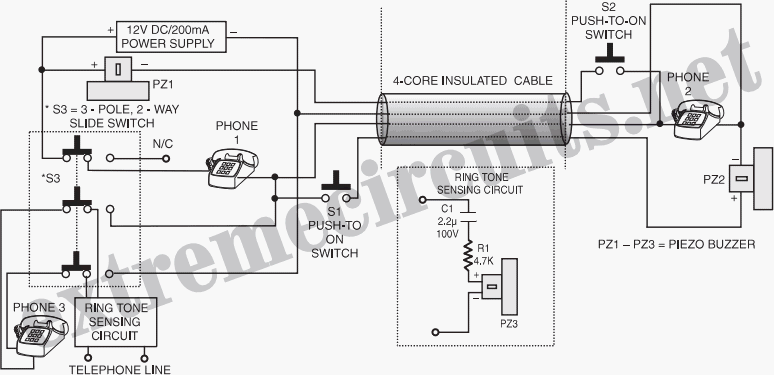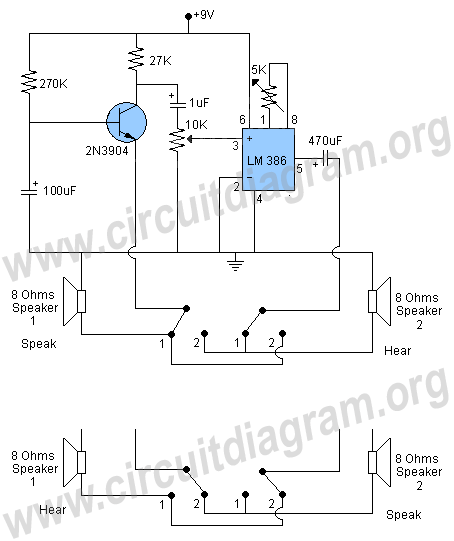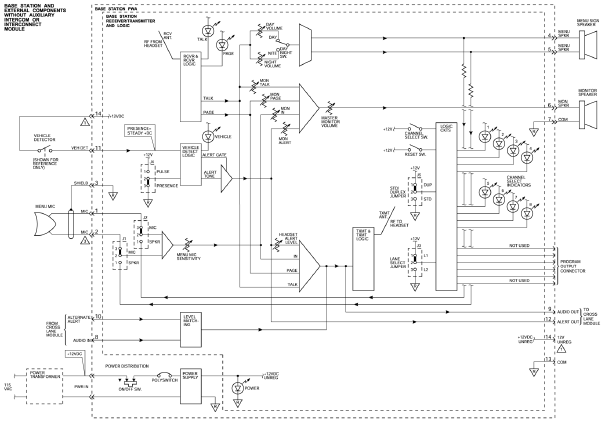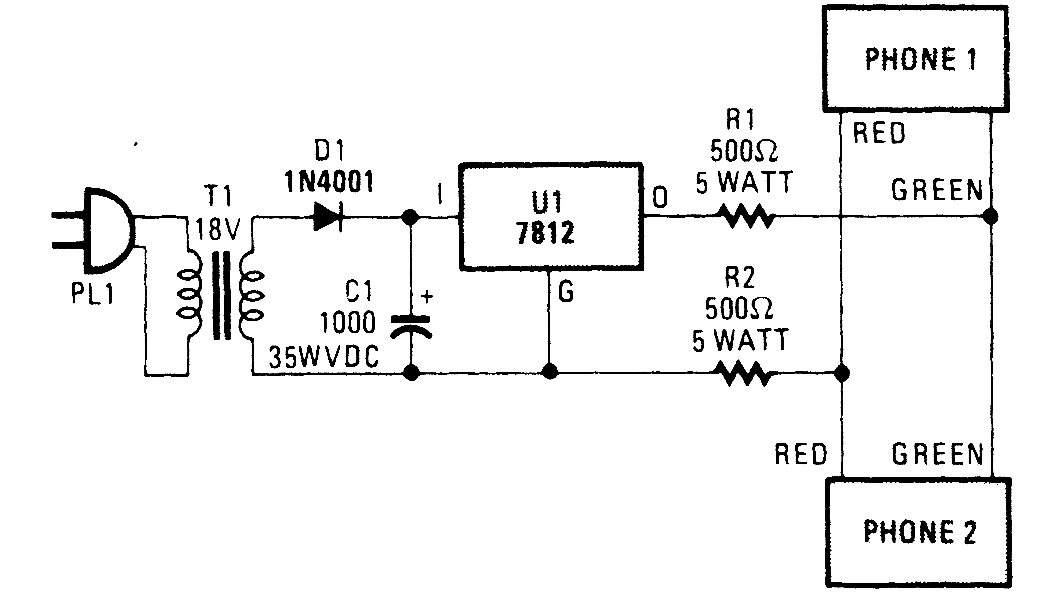
Full-duplex Intercom
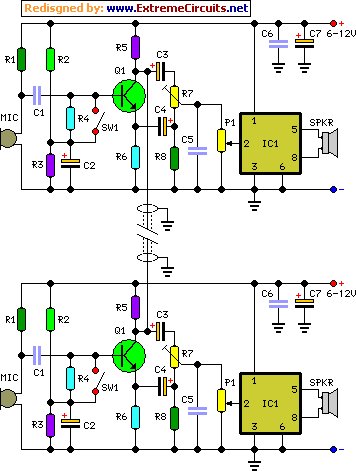
This design enables the operation of two intercom stations without requiring the operator to use their hands for a "push-to-talk" mode. The two units are connected via a thin screened cable, eliminating the need for complex changeover switching. Both microphones and loudspeakers are always active. A special circuit is implemented to prevent the loudspeaker output from being picked up by the microphone in the same unit, which would create an undesirable loud "howl" known as the "Larsen effect." A "Private" switch is included to mute the microphone when necessary. The circuit utilizes the TDA7052 audio power amplifier IC, which can deliver approximately 1 Watt of output power with a supply voltage ranging from 6 to 12 volts. A distinctive feature of this design is the microphone amplifier Q1, which provides a 180° phase-shifted audio output at the Collector and an in-phase output at the Emitter. These outputs are mixed using the C3, C4, R7, and R8 network, with R7 being adjusted until the two signals nearly cancel each other out. This results in the loudspeaker producing a very faint version of the microphone's signals. Meanwhile, since the Collectors of both intercom units are connected, the 180° phase-shifted signal is transmitted to the audio amplifier of the second unit without attenuation, allowing it to be clearly reproduced by its loudspeaker. The same process occurs when speaking into the second unit’s microphone: if R7 is correctly adjusted, minimal output will be heard from its loudspeaker, while a clear reproduction will be heard from the first unit. The circuit diagram illustrates the doubled configuration. The two units can be assembled in separate enclosures and linked by a thin screened cable of desired length. By placing the power supply in one unit's enclosure, the other unit can be powered through a two-wire screened cable, with the second wire serving as the positive DC path. To set up the circuit, the volume control (P1) of the first unit should be turned near maximum, and while speaking into the microphone, Trimmer R7 should be adjusted until the voice becomes nearly inaudible through the loudspeaker of the same unit.
The intercom design employs a straightforward architecture that enhances usability and minimizes feedback issues. The use of the TDA7052 audio power amplifier is particularly advantageous due to its efficiency and ability to deliver sufficient power for intercom applications. The design's focus on preventing feedback through careful phase manipulation of the microphone signals is critical in maintaining audio clarity and user comfort.
To elaborate on the circuit components, the TDA7052 IC is a low-voltage audio amplifier with built-in gain control, making it suitable for battery-powered applications. Its ability to operate within a 6V to 12V range allows for flexibility in power supply selection. The microphone amplifier Q1 plays a pivotal role in signal processing, where the phase-shifted output is essential for the feedback cancellation strategy. Capacitors C3 and C4, along with resistors R7 and R8, form a mixing network that finely tunes the balance between the in-phase and out-of-phase signals, ensuring that the loudspeaker output remains at a low level while still allowing the second unit to receive a clear signal.
The inclusion of the "Private" switch enhances the functionality of the intercom, providing users the option to mute the microphone when privacy is required. This feature is particularly useful in environments where confidentiality is necessary. The design's modularity allows for easy installation and expansion, as the two units can be placed in different locations while still maintaining a reliable connection through the screened cable.
Overall, this intercom design exemplifies an effective solution for hands-free communication, addressing common issues such as feedback while providing user-friendly features that enhance the overall experience.This design allows to operate two intercom stations leaving the operator free of using his/her hands in some other occupation, thus avoiding the usual "push-to-talk" operation mode. No complex changeover switching is required: the two units are connected together by means of a thin screened cable.
As both microphones and loudspeakers are always in operation, a special circuit is used to avoid that the loudspeaker output can be picked-up by the microphone enclosed in the same box, causing a very undesirable and loud "howl", i. e. the well known "Larsen effect". A "Private" switch allows microphone muting, if required. The circuit uses the TDA7052 audio power amplifier IC, capable of delivering about 1 Watt of output power at a supply voltage comprised in the 6 - 12V range.
The unusual feature of this design is the microphone amplifier Q1: its 180 ° phase-shifted audio output taken at the Collector and its in-phase output taken at the Emitter are mixed by the C3, C4, R7 and R8 network and R7 is trimmed until the two incoming signals almost cancel out. In this way, the loudspeaker will reproduce a very faint copy of the signals picked-up by the microphone.
At the same time, as both Collectors of the two intercom units are tied together, the 180 ° phase-shifted signal will pass to the audio amplifier of the second unit without attenuation, so it will be loudly reproduced by its loudspeaker. The same operation will occur when speaking into the microphone of the second unit: if R7 will be correctly set, almost no output will be heard from its loudspeaker but a loud and clear reproduction will be heard at the first unit output.
The circuit is shown already doubled in the diagram. The two units can be built into two separate boxes and connected by a thin screened cable having the length desired. Enclosing the power supply in the box of one unit, the other unit can be easily fed by using a two-wire screened cable, its second wire becoming the positive dc path.
To setup the circuit, rotate the volume control (P1) of the first unit near its maximum and speak into the microphone. Adjust Trimmer R7 until your voice becomes almost inaudible when reproduced by the loudspeaker of the same unit.
🔗 External reference
The intercom design employs a straightforward architecture that enhances usability and minimizes feedback issues. The use of the TDA7052 audio power amplifier is particularly advantageous due to its efficiency and ability to deliver sufficient power for intercom applications. The design's focus on preventing feedback through careful phase manipulation of the microphone signals is critical in maintaining audio clarity and user comfort.
To elaborate on the circuit components, the TDA7052 IC is a low-voltage audio amplifier with built-in gain control, making it suitable for battery-powered applications. Its ability to operate within a 6V to 12V range allows for flexibility in power supply selection. The microphone amplifier Q1 plays a pivotal role in signal processing, where the phase-shifted output is essential for the feedback cancellation strategy. Capacitors C3 and C4, along with resistors R7 and R8, form a mixing network that finely tunes the balance between the in-phase and out-of-phase signals, ensuring that the loudspeaker output remains at a low level while still allowing the second unit to receive a clear signal.
The inclusion of the "Private" switch enhances the functionality of the intercom, providing users the option to mute the microphone when privacy is required. This feature is particularly useful in environments where confidentiality is necessary. The design's modularity allows for easy installation and expansion, as the two units can be placed in different locations while still maintaining a reliable connection through the screened cable.
Overall, this intercom design exemplifies an effective solution for hands-free communication, addressing common issues such as feedback while providing user-friendly features that enhance the overall experience.This design allows to operate two intercom stations leaving the operator free of using his/her hands in some other occupation, thus avoiding the usual "push-to-talk" operation mode. No complex changeover switching is required: the two units are connected together by means of a thin screened cable.
As both microphones and loudspeakers are always in operation, a special circuit is used to avoid that the loudspeaker output can be picked-up by the microphone enclosed in the same box, causing a very undesirable and loud "howl", i. e. the well known "Larsen effect". A "Private" switch allows microphone muting, if required. The circuit uses the TDA7052 audio power amplifier IC, capable of delivering about 1 Watt of output power at a supply voltage comprised in the 6 - 12V range.
The unusual feature of this design is the microphone amplifier Q1: its 180 ° phase-shifted audio output taken at the Collector and its in-phase output taken at the Emitter are mixed by the C3, C4, R7 and R8 network and R7 is trimmed until the two incoming signals almost cancel out. In this way, the loudspeaker will reproduce a very faint copy of the signals picked-up by the microphone.
At the same time, as both Collectors of the two intercom units are tied together, the 180 ° phase-shifted signal will pass to the audio amplifier of the second unit without attenuation, so it will be loudly reproduced by its loudspeaker. The same operation will occur when speaking into the microphone of the second unit: if R7 will be correctly set, almost no output will be heard from its loudspeaker but a loud and clear reproduction will be heard at the first unit output.
The circuit is shown already doubled in the diagram. The two units can be built into two separate boxes and connected by a thin screened cable having the length desired. Enclosing the power supply in the box of one unit, the other unit can be easily fed by using a two-wire screened cable, its second wire becoming the positive dc path.
To setup the circuit, rotate the volume control (P1) of the first unit near its maximum and speak into the microphone. Adjust Trimmer R7 until your voice becomes almost inaudible when reproduced by the loudspeaker of the same unit.
🔗 External reference
